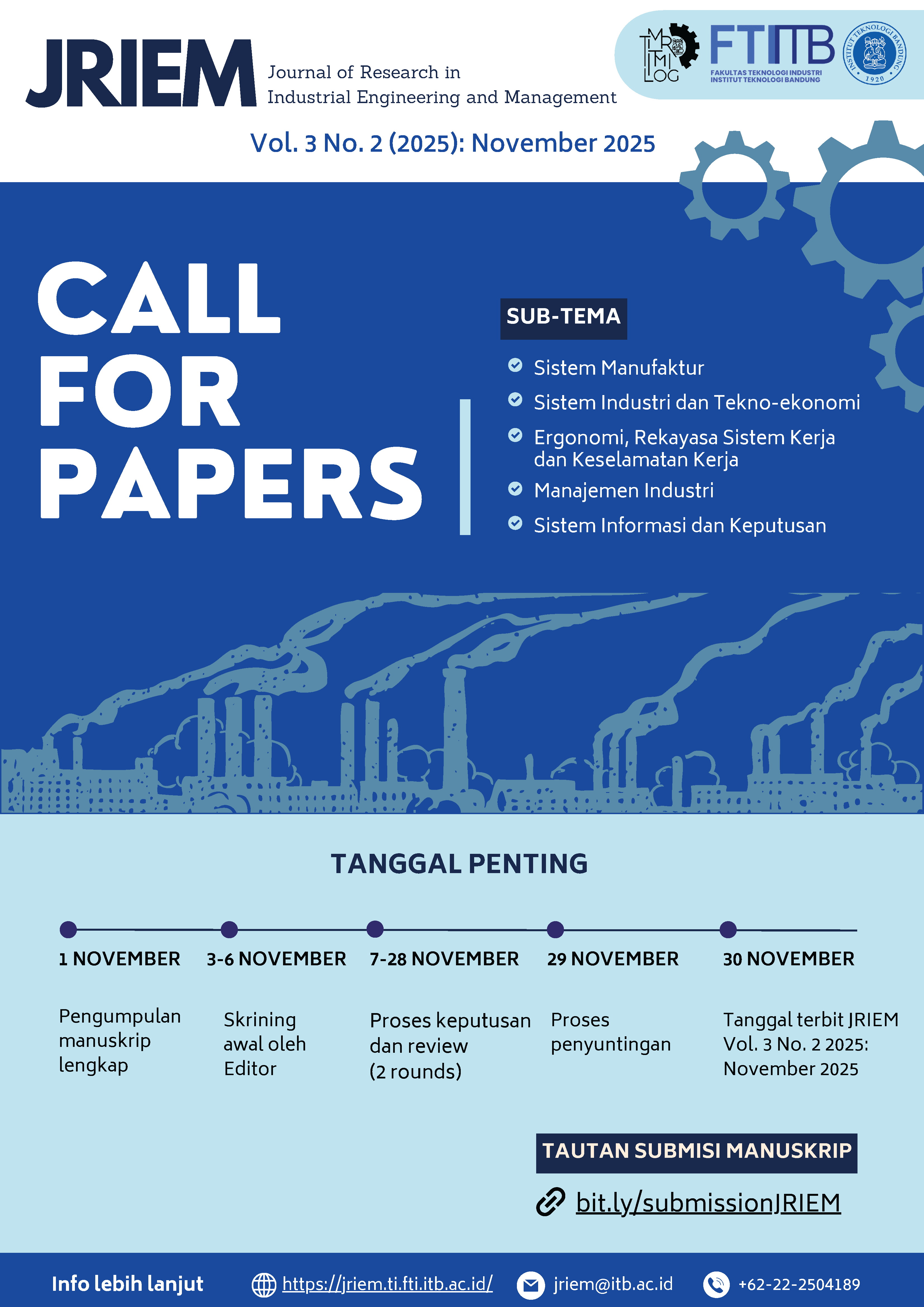Proposed Design Improvements for Earplugs Considering the Factors Affecting Their Comfort
DOI:
https://doi.org/10.61221/jriem.v3i1.67Abstrak
The low compliance with earplug uses in Indonesian workplaces reflects suboptimal occupational safety and health (K3) implementation, particularly in protecting workers from noise exposure, with discomfort cited as a primary cause. This study investigates factors influencing earplug comfort and proposes user-oriented design improvements. Comfort was measured using the COmfort of hearing PROtection device (COPROD) questionnaire across four dimensions that include physical, functional, acoustic, and psychological, based on responses from 458 users. Data were analyzed using partial least squares structural equation modeling (PLS-SEM) and importance-performance map analysis (IPMA). Results show all four dimensions significantly affect overall comfort, with physical comfort emerging as the most critical yet underperforming factor, making it the primary target for enhancement. Functional comfort also demonstrated below-average performance but with lower relative importance, positioning it as a secondary priority. Key comfort attributes were then converted into functional and technical requirements, informing targeted design interventions to improve earplug performance and user acceptance.
Referensi
1. Abbasi, M., Derakhshan, J., Darabi, F., Abdullah, M. N., Mahmood, E. A., Eskandari, T., & Yazdanirad, S. (2024). The impact of noise-induced hearing loss on individual job performance: Exploring the role of aggression and work-related quality of life. BMC Psychology, 12(1), 624. https://doi.org/10.1186/s40359-024-02113-w
2. Adiratna, Y., Astono, S., Fertiaz, M., & Subhan. (2022). The Indonesian national occupational safety and health profile in 2022. Jakarta: Ministry of Manpower of the Republic of Indonesia.
3. Aiyer, P. (2021). Noise pollution due to construction activities. Retrieved July 12, 2025, from https://www.researchgate.net/publication/373143707
4. Alamoudi, M. (2022). The integration of NOSACQ-50 with importance–performance analysis technique to evaluate and analyze safety climate dimensions in the construction sector in Saudi Arabia. Buildings, 12(11), 1855. https://doi.org/10.3390/buildings12111855
5. Ambar, E., & Suraya, A. (2022). Prevalence and risk factors of hearing disorders among construction industry workers in Indonesia [in Indonesian]. Binawan Student Journal, 4(2), 14–20. https://doi.org/10.54771/bsj.v4i2.459
6. Arezes, P. M., & Miguel, A. S. (2002). Hearing protectors acceptability in noisy environments. The Annals of Occupational Hygiene, 46(6), 531–536. https://doi.org/10.1093/annhyg/mef067
7. Ashfaq, A., Cronin, N., & Müller, P. (2022). Recent advances in machine learning for maximal oxygen uptake (VO₂ max) prediction: A review. Informatics in Medicine Unlocked, 28, 100863. https://doi.org/10.1016/j.imu.2022.100863
8. Becker, J.-M., Klein, K., & Wetzels, M. (2012). Hierarchical latent variable models in PLS-SEM: Guidelines for using reflective–formative type models. Long Range Planning, 45(5–6), 359–394. https://doi.org/10.1016/j.lrp.2012.10.001
9. Bridger, R. S. (2003). Introduction to ergonomics (2nd ed.). New York: Taylor & Francis.
10. Byrne, D., Davis, R., Shaw, P., Specht, B., & Holland, A. (2011). Relationship between comfort and attenuation measurements for two types of earplugs. Noise & Health, 13(51), 86–92. https://doi.org/10.4103/1463-1741.77193
11. Casali, J. G., & Gerges, S. N. (2007). Hearing protectors. In M. J. Crocker (Ed.), Handbook of noise and vibration control. Hoboken, NJ: John Wiley & Sons.
12. CDC. (2021, October 7). Study finds over half of noise-exposed workers do not use hearing protection when exposed to noise on the job. National Institute for Occupational Safety and Health (NIOSH). Retrieved May 13, 2025, from https://www.cdc.gov/niosh/updates/upd-10-07-21.html Interpretation of formative measurement in information systems research. MIS Quarterly, 33(4), 689–707. https://doi.org/10.2307/20650323
13. Centefelli, R. T., & Bassellier, G. (2009). Interpretation of formative measurement in information systems research. MIS Quarterly, 33(4), 689–707. https://doi.org/10.2307/20650323
14. Coles, R. R., & Rice, C. G. (1966). Speech communication effects and temporary threshold shift reduction provided by V51R and Selectone-K earplugs under conditions of high intensity impulsive noise. Journal of Sound and Vibration, 4(2), 156–171. https://doi.org/10.1016/0022-460X(66)90119-2
15. Copelli, F. (2021). Field attenuation of foam earplugs. Safety and Health at Work, 12(2), 184–191. https://doi.org/10.1016/j.shaw.2020.09.006
16. Dean, J. T. (2024, October 17). Loud workplaces can cause hearing loss, but can they also hurt workers’ productivity and performance? VoxDev. Retrieved June 2, 2025, from https://voxdev.org/topic/firms/impacts-noisy-workplaces-productivity#:~:text=Decades%20of%20psychology%20research%20suggests,productive%20in%20these%20noisy%20conditions
17. Dharmawan, M. A., Mufidah, I., Martini, S., & Akbar, M. D. (2023). The development of patient monitoring system application: Integrating design thinking and QFD method. International Journal of Social Service and Research, 3(6), 1452–1461. https://doi.org/10.46799/ijssr.v3i6.386
18. Dieter, G. E., & Schmidt, L. C. (2021). Engineering design (6th ed.). New York: McGraw-Hill LLC.
19. Dijkstra, T. K., & Henseler, J. (2015). Consistent partial least squares path modeling. MIS Quarterly, 39(2), 297–316. https://doi.org/10.25300/MISQ/2015/39.2.02
20. Field, A. (2013). Discovering statistics using IBM SPSS statistics (4th ed.). London: SAGE.
21. Firman, A. (2022). Implementation of occupational safety and health (K3) for increasing employee productivity. Jurnal Economic Resources, 5(2), 365–376. http://repository.nobel.ac.id/id/eprint/114
22. Gao, Q., & Zhu, Q. (2009). Formation of highly hydrophobic surfaces on cotton and polyester fabrics using silica sol nanoparticles and nonfluorinated alkylsilane. Industrial & Engineering Chemistry Research, 48(22), 9797–9803. https://doi.org/10.1021/ie9005518
23. Gedik Toker, Ö., Tas Elibol, N., Kuru, E., Görmezoğlu, Z., Görener, A., & Toker, K. (2025). Industrial noise impacts on workers' health and performance below permissible limits. BMC Public Health, 25(1), 1615. https://doi.org/10.1186/s12889-025-22732-1
24. Gong, W., & Feng, H. A. (2023). Evaluating earplug performance over a 2-hour work period with a fit-test system. Seminars in Hearing, 44(4), 470–484. https://doi.org/10.1055/s-0043-1769586
25. Hair, J. F., Black, W. C., Babin, B. J., & Anderson, R. E. (2019). Multivariate data analysis (8th ed.). Harlow, England: Pearson Prentice Hall.
26. Hair, J. F., Hult, G. T., Ringle, C. M., Sarstedt, M., Danks, N. P., & Ray, S. (2021). Partial least squares structural equation modeling (PLS-SEM) using R. Classroom Companion: Business. https://doi.org/10.1007/978-3-030-80519-7
27. Hansen, M. Ø. (1997). Occlusion effects, Part I. Department of Acoustic Technology, Technical University of Denmark.
28. HexArmor. (2021, February 8). What are OSHA’s requirements for hearing protection? Retrieved June 2, 2025, from https://www.hexarmor.com/posts/what-are-osha-requirements-for-hearing-protection
29. IHC. (2025). Custom molded ear plugs. Retrieved May 13, 2025, from http://ihc.co.id/custom-molded-ear-plugs/
30. International Labour Organization. (2011, March 17). Hearing protection. Retrieved May 13, 2025, from https://www.iloencyclopaedia.org/part-iv-66769/personal-protection-59388/item/690-hearing-protection
31. Iridiastadi, H., & Yassierli. (2015). Ergonomi: Suatu pengantar. Bandung: PT Remaja Rosdakarya.
32. International Organization for Standardization. (2011). ISO 26800:2011 ergonomics — General approach, principles and concepts. Geneva, Switzerland: ISO.
33. International Organization for Standardization. (2018). ISO 4869-1:2018 acoustics — Hearing protectors — Part 1: Subjective method for the measurement of sound attenuation. Retrieved May 27, 2025, from https://www.iso.org/obp/ui/#iso:std:iso:4869:-1:ed-2:v1:en
34. Kementerian Ketenagakerjaan Republik Indonesia. (2010, July 6). Peraturan Menteri Tenaga Kerja dan Transmigrasi Republik Indonesia Nomor PER.8/MEN/VII/2020. Retrieved June 2, 2025, from https://jdih.kemnaker.go.id/asset/data_puu/peraturan_file_PER08.pdf
35. Kim, D. K., & Park, S. (2021). An analysis of the effects of occupational accidents on corporate management performance. Safety Science, 138, 105228. https://doi.org/10.1016/j.ssci.2021.105228
36. Krayner, N., & Katz, R. (2018). Measuring simplicity in mechanical design. Procedia Manufacturing, 21, 878–889. https://doi.org/10.1016/j.promfg.2018.02.196
37. Kwak, C., & Han, W. (2021). The effectiveness of hearing protection devices: A systematic review and meta-analysis. International Journal of Environmental Research and Public Health, 18(21), 11693. https://doi.org/10.3390/ijerph182111693
38. Li, W. L. (2018). The effect of moisture on friction coefficient of fabrics used on taekwondo personal protective equipment. Journal of Engineering Tribology, 233(1), 1–8. https://doi.org/10.1177/1350650118770071
39. Liu, F., Jiang, S., Kang, J., Wu, Y., Yang, D., Meng, Q., & Wang, C. (2022). On the definition of noise. Humanities and Social Sciences Communications, 9(1). https://doi.org/10.1057/s41599-022-01431-x
40. Lizák, P., & Mojumdar, S. C. (2015). Influence of the material structure on the thermal conductivity 1. of clothing textiles. Journal of Thermal Analysis and Calorimetry, 119, 865–869. https://doi.org/10.1007/s10973-014-4112-9
41. Malhotra, N. K. (2010). Marketing research: An applied orientation. Upper Saddle River, NJ: Prentice Hall.
42. Malhotra, N. K., & Birks, D. F. (2007). Marketing research: An applied approach (3rd ed.). Harlow, England: Pearson Education.
43. Martin, B. (2014, December 14). Study of the occlusion effect induced by an earplug: Numerical modelling and experimental validation. Retrieved July 18, 2025, from https://www.proquest.com/docview/1667729626
44. Terroir, J., Perrin, N., & Wild, P. (2022). Comfort of earplugs: results of a field survey based on the COPROD questionnaire. Ergonomics, 65(9), 1173–1193. https://doi.org/10.1080/00140139.2021.1990415
45. Wang, T., Wang, Y., Yu, G., Chen, Z., Li, Z. (2024). Analysis and Validation on Multi-dimensional Assessment for Comfort of In-Ear Headphones. In: Duffy, V.G. (eds) Digital Human Modeling and Applications in Health, Safety, Ergonomics and Risk Management. HCII 2024. Lecture Notes in Computer Science, vol 14709. Springer, Cham. https://doi.org/10.1007/978-3-031-61060-8_10
Unduhan
Diterbitkan
Cara Mengutip
Terbitan
Bagian
Lisensi
Hak Cipta (c) 2025 Aqila, Ari Widyanti

Artikel ini berlisensi Creative Commons Attribution 4.0 International License.




